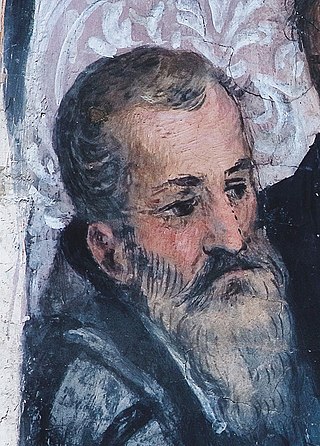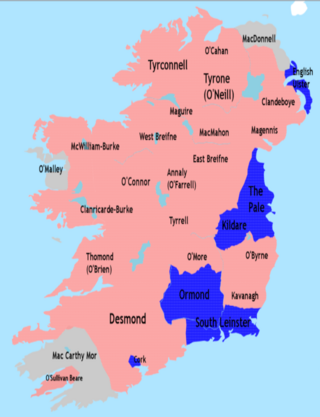
Hugh O'Neill was an Irish Gaelic lord, Earl of Tyrone and was later created The Ó Néill Mór, Chief of the Name. O'Neill's career was played out against the background of the Tudor conquest of Ireland, and he is best known for leading a coalition of Irish clans during the Nine Years' War, the strongest threat to the House of Tudor in Ireland since the uprising of Silken Thomas against King Henry VIII.

Sir Turlough Lynagh O'Neill was an Irish Gaelic lord of Tír Eoghain in early modern Ireland. He was inaugurated upon Shane O’Neill’s death, becoming The O'Neill. From 1567 to 1595, Sir Turlough Luineach O'Neill was leader of the O'Neill clan, the most powerful family in Ulster, the northern province in Ireland. He was knighted in 1578.

Shane O'Neill was an Irish chieftain of the O'Neill dynasty of Ulster in the mid-16th century. Shane O'Neill's career was marked by his ambition to be the O'Neill—sovereign of the dominant O'Neill family of Tír Eoghain. This brought him into conflict with competing branches of the O'Neill family and with the English government in Ireland, who recognised a rival claim. Shane's support was considered worth gaining by the English even during the lifetime of his father Conn O'Neill, 1st Earl of Tyrone. But rejecting overtures from Thomas Radclyffe, 3rd Earl of Sussex, the lord deputy from 1556, Shane refused to help the English against the Scottish settlers on the coast of Antrim, allying himself for a short time instead with the MacDonnells, the most powerful of these settlers. Shane viewed the Scottish settlers as invaders, but decided to stay his hand against them with hopes of using them to strengthen his position with the English. However, tensions quickly boiled over and he declared war on the Scottish MacDonnell's defeating them at the Battle of Glentaisie despite the MacDonnells calling for reinforcements from Scotland. The Scottish MacDonnells would later assassinate Shane O'Neill and collect the bounty on his head.

Rory O'Donnell, 1st Earl of Tyrconnell, was an Irish Gaelic lord, the last King of Tyrconnell. He was the younger brother of Hugh Roe O'Donnell and the 1st Earl of Tyrconnell.
Hugh Roe O'Donnell, also known as Red Hugh O'Donnell, was a sixteenth-century leader of the Gaelic nobility of Ireland. He became Chief of the Name of Clan O'Donnell and Lord of Tír Chonaill in 1593, after escaping a five-year imprisonment without trial in Dublin Castle and following a lengthy succession dispute within the derbhfine of the O'Donnell dynasty. Along with his father-in-law Hugh O'Neill of Tyrone, he led an alliance of Irish clans in the Nine Years' War against the English government in Ireland. Hugh Roe led an Irish army to victory in the Battle of Curlew Pass. After defeat in the Siege of Kinsale, he travelled to Spain to seek support from King Philip III. Unsuccessful, he died in Spain and was succeeded by his younger brother Rory O'Donnell. He is sometimes also known as Aodh Ruadh II or Red Hugh II, especially in his native County Donegal.

The Nine Years' War, sometimes called Tyrone's Rebellion, took place in Ireland from 1593 to 1603. It was fought between an Irish confederation—led mainly by Hugh O'Neill of Tyrone and Hugh Roe O'Donnell of Tyrconnell—against English rule in Ireland, and was a response to the ongoing Tudor conquest of Ireland. The war began in Ulster and northern Connacht, but eventually engulfed the entire island. The Irish alliance won numerous victories against the English forces in Ireland, such as the Battle of Clontibret (1595) and the Battle of the Yellow Ford (1598), but the English won a pivotal victory against the alliance and their Spanish allies in the siege of Kinsale (1601–02). The war ended with the Treaty of Mellifont (1603). Many of the defeated northern lords left Ireland to seek support for a new uprising in the Flight of the Earls (1607), never to return. This marked the end of Gaelic Ireland and led to the Plantation of Ulster.
Aodh Mag Uidhir, anglicised as Hugh Maguire was Chief of the Name of the Irish clan Maguire and Lord of Fermanagh during the reign of Elizabeth I. He died in battle resisting the Tudor conquest of Ireland as part of the Nine Years War.

Tír Eoghain, also known as Tyrone, was a kingdom and later earldom of Gaelic Ireland, comprising parts of present-day County Tyrone, County Armagh, County Londonderry and County Donegal (Raphoe). The kingdom represented the core homeland of the Cenél nEógain people of the Northern Uí Néill and although they ruled, there were smaller groups of other Gaels in the area. One part of the realm to the north-east broke away and expanded, becoming Clandeboye, ruled by a scion branch of the O'Neill dynasty. In one form or another, Tyrone existed for over a millennium. Its main capital was Dungannon, though kings were inaugurated at Tullyhogue Fort.
Finola MacDonald, styled after her marriage as Dame Finola Ó Domhnaill or Finola, Lady Ó Domhnaill, and better known by the Irish nickname Iníon Dubh, was queen consort of Tyrconnell. She was the daughter of Séamus Mac Dhòmhnaill, 6th Laird of Dunnyveg, and his wife, Lady Agnes MacDonald, and became the second wife of Sir Aodh mac Maghnusa Ó Domhnaill, king of Tyrconnell. She was the mother of eight children, including four sons. Her offspring included Hugh Roe O'Donnell, Rory, 1st Earl of Tyrconnell, and Cathbarr O'Donnell.
Sir Hugh McManus O'Donnell was an Irish Gaelic lord. He was The O'Donnell of his clan, and king of Tyrconnell in medieval Ireland.
Henry MacShane O'Neill or Anraí mac Seáin Ó Néill was an Irish flaith, a son of Shane O'Neill. He was the leader of the MacShane in the late 16th century and early 17th century, and sought control of the O'Neill Clan, fighting with his brother against Hugh O'Neill.

Donegal Abbey is a ruined Franciscan Priory in Donegal in Ireland. It was constructed by the O'Donnell dynasty in the fifteenth century. It is sometimes referred to as Donegal Friary.
Sir Donal O'Donnell was a member of the O'Donnell dynasty of Tyrconnell in modern-day County Donegal. He was the eldest son of Sir Hugh McManus O'Donnell, the Lord of Tyrconnell for much of the reign of Elizabeth I.
Hugh Dubh O'Donnell was a member of the O'Donnell dynasty of Tyrconnell in modern-day County Donegal. He was the younger brother of Manus O'Donnell, the ruler of Tyrconnell between 1537 and 1555. When his brother died, Hugh Dubh unsuccessfully challenged for the lordship, which was held by his two nephews, Calvagh O'Donnell and Sir Hugh O'Donnell. He was supported in his claim by Miler Magrath who suggested that his seniority in the family made him the rightful candidate.
The Battle of Doire Leathan took place on 14 September 1590 at Doire Leathan, a townland and hamlet located between Kilcar and Carrick in south-western County Donegal in Ulster, Ireland. Derrylahan is on the eastern shores of Teelin Bay, being just across from the village of Teelin. The battle was part of the ongoing succession dispute for the leadership of the Gaelic lordship of O'Donnell. A combined force of Irish clans and Scottish Redshank mercenaries hired by Iníon Dubh defeated and killed Sir Domhnall Ó Domhnaill. The Tanist of Tír Conaill, Sir Domhnall's younger half-brother and Iníon Dubh's son, Red Hugh O'Donnell, was still imprisoned in Dublin Castle, but later rose following a subsequent escape to lead Clan O'Donnell and was a prominent figure during the Nine Years War.

The siege of Enniskillen took place at Enniskillen in Fermanagh, Ireland, in 1594 and 1595, during the Nine Years' War. In February 1594, the English had captured Enniskillen Castle from the Irish after a waterborne assault and massacred the defenders after they surrendered. From May 1594, an Irish army under Hugh Maguire and Cormac MacBaron O'Neill besieged the English garrison in the castle, and in August they defeated an English relief force. A second relief force was allowed to resupply the garrison, but the castle remained cut off. Eventually, in May 1595, the English garrison surrendered to the Irish and were then massacred.
Captain Humphrey Willis was an English soldier in Ireland in the sixteenth century, his parents are unknown. Captain Willis was appointed Sheriff of County Donegal and County Fermanagh by the Lord Deputy of Ireland William FitzWilliam. Captain Willis was a fluent speaker of Irish, and enforced his authority with a detachment of the Irish Army.
William Mostian or Mostyn was a soldier and public official in sixteenth century Ireland.
Nuala O'Donnell was a member of the O'Donnell dynasty in sixteenth century Ireland who took part in the 1607 Flight of the Earls.
The Battle of Belleek, also known as the Battle of the Erne Fords, was fought on the River Erne near Belleek in Fermanagh, Ireland, on 10 October 1593. It was part of the buildup to the Nine Years' War. The battle was fought between a Gaelic Irish army under Hugh Maguire, lord of Fermanagh—who had begun a revolt against the English—and an English Crown expeditionary force under Sir Henry Bagenal, supported by Hugh O'Neill, Earl of Tyrone. Maguire's force was defeated, but the bulk of his army was unscathed. Hugh O'Neill would later join Maguire in war against the English.







